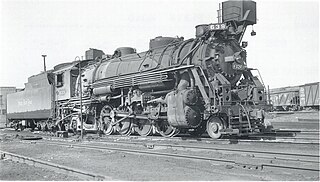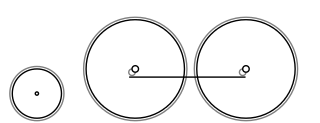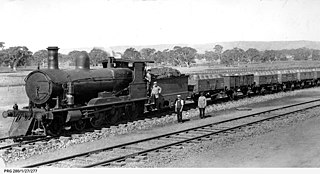
Under the Whyte notation for the classification of steam locomotives, 0-6-0 represents the wheel arrangement of no leading wheels, six powered and coupled driving wheels on three axles and no trailing wheels. This was the most common wheel arrangement used on both tender and tank locomotives in versions with both inside and outside cylinders.

4-4-0 is a locomotive type with a classification that uses the Whyte notation for the classification of steam locomotives by wheel arrangement and represents the arrangement: four leading wheels on two axles, four powered and coupled driving wheels on two axles, and a lack of trailing wheels. Due to the large number of the type that were produced and used in the United States, the 4-4-0 is most commonly known as the American type, but the type subsequently also became popular in the United Kingdom, where large numbers were produced.

Under the Whyte notation for the classification of steam locomotives, 2-8-2 represents the wheel arrangement of two leading wheels on one axle, usually in a leading truck, eight powered and coupled driving wheels on four axles and two trailing wheels on one axle, usually in a trailing truck. This configuration of steam locomotive is most often referred to as a Mikado, frequently shortened to Mike.

Under the Whyte notation for the classification of steam locomotives, 2-4-0 represents the wheel arrangement of two leading wheels on one axle, four powered and coupled driving wheels on two axles and no trailing wheels.
The DD class (later reclassified into D1, D2 and D3 subclasses) was a passenger and mixed traffic steam locomotive that ran on Victorian Railways from 1902 to 1974. Originally introduced on mainline express passenger services, they were quickly superseded by the much larger A2 class and were relegated to secondary and branch line passenger and goods service, where they gave excellent service for the next fifty years. The DD design was adapted into a 4-6-2T tank locomotive for suburban passenger use, the DDE (later D4) class. They were the most numerous locomotive class on the VR, with a total of 261 DD and 58 locomotives built.

The Western Australian Government Railways operated many unique steam, diesel and electric locomotive classes. Often suffering from lack of available funds the WAGR locomotive fleet often consisted of locomotives far older than their expected operational life. Only one electric locomotive was operated by the government during the WAGR years.

The South Australian Railways 600 class was a class of 4-6-2 steam locomotives operated by the South Australian Railways.

The South Australian Railways R class engine, later upgraded to Rx Class engine is a class of 4-6-0 steam engines operated by the South Australian Railways.

The South Australian Railways P class was a class of 2-4-0T steam locomotives operated by the South Australian Railways.

The South Australian Railways E class was a class of 2-4-0 steam locomotives acquired to work passenger and goods train services on the South Australian Railways broad gauge system.

The South Australian Railways A Class locomotives arrived for the South Australian Railways in September and October 1868 from Robert Stephenson and Company. A third and final locomotive was ordered and arrived in 1873, these locomotives were withdrawn between 1893 and 1924 from the SAR after many years of hard service.

The South Australian Railways C Class locomotives were built by the Robert Stephenson and Company for the South Australian Railways in 1856. The first locomotive was in service by November 1856, with the second engine in service by January 1857. They were both withdrawn after long service lives, with No. 5 being withdrawn after 50 years working on the SAR. No. 6 lasted well into Commissioner Webbs era, finally being withdrawn in 1926 at almost 70 years old.

The South Australian Railways G Class locomotives first appeared on the South Australian Railways in 1869 after being purchased from Beyer, Peacock and Company. More locomotives were purchased and in service by 1880, and again in 1886. The G class was extinct by 1923.

The South Australian Railways H Class locomotives were built by Robert Stephenson and Company in 1870 for the South Australian Railways. The first of three numbered 25, 26 and 27 were all in service by June 1871. After being a well received class, two more locomotives were ordered and were in service by October 1872. Nos. 30 and 31 arrived in August 1874. The final two locomotives ordered for the SAR arrived in August 1877 and were numbered 2 and 3. These locomotives worked on the SAR system for many years, with only one member of the class being withdrawn in 1888. The rest of the class were rebuilt over the years and lasted well into the next century with, the final locomotive being withdrawn by 1930.

Eighteen South Australian Railways K class (broad-gauge) locomotives were built by Beyer, Peacock and Company for the South Australian Railways (SAR) between 1878 and 1884. Despite having a fundamental design flaw that affected their original role as light-line passenger locomotives, they eventually performed shunting duties exclusively. They operated for six decades.

Four South Australian Railways L class broad-gauge locomotives with a 4-4-0 wheel arrangement were built by Beyer, Peacock and Company in 1879 and entered service in March–April 1880. They were condemned in 1928 and 1931, and were subsequently scrapped.

The South Australian Railways M Class (1st) locomotives were originally built by the Avonside Engine Company for the Canterbury Provincial Railways in 1868 to 1874. They were later sent to South Australia in 1878 and were first in service on the South Australian Railways between 1880 and 1881.

The South Australian Railways N Class locomotives were built in 1881 by the Baldwin Locomotive Works for the South Australian Railways (S.A.R.). They were rebuilt in 1904, which vastly improved their performance and completely changed their look from a typical American locomotive of the time to a more British one.

The South Australian Railways O Class (1st) locomotives were built by Baldwin Locomotive Works for the South Australian Railways (SAR). They entered service in 1881 on the SAR system and were both withdrawn and scrapped by 1904.

The South Australian Railways O Class (2nd) locomotive was a 4-4-0WT built by Robert Stephenson and Company in 1868 for the Launceston and Western Railway Company. It entered service with the South Australian Railways in 1912 and was cut up in 1930.



















